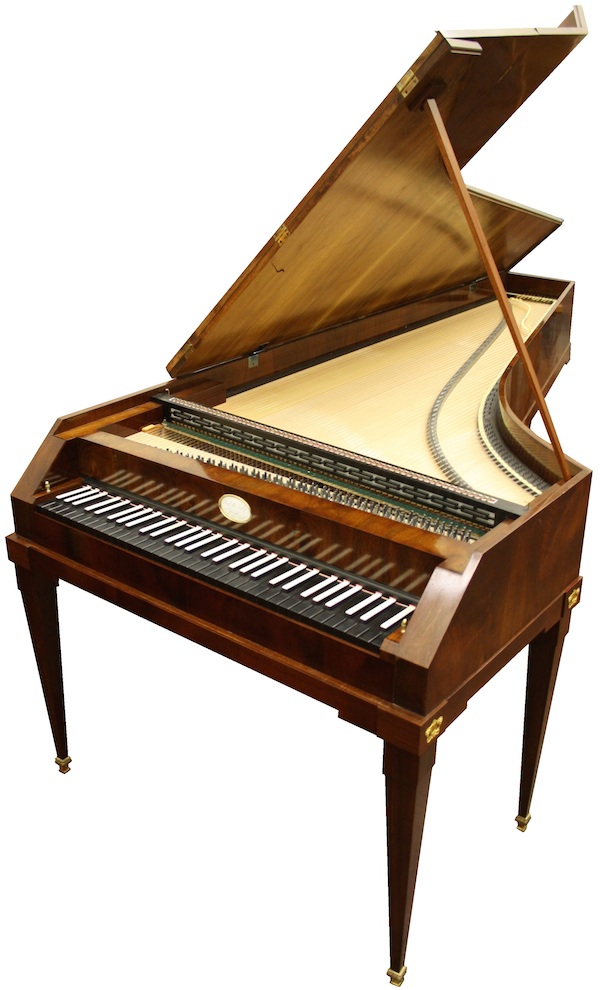
The word ‘fortepiano’ denotes the earlier mutations of the piano, from its invention by Bartolomeo Cristofori around 1700 through the era of Viennese Classicism and into the early decades of the 19th century. By the late 19th century, pianos had come to inherit many of the features characteristic of today’s pianos; the word ‘fortepiano’ does not apply to the instruments of that time, or afterward.
Fortepianos vary greatly in their construction and design, for which there are a few reasons. Firstly, instruments of earlier times were not comprehensively standardised; hand-made instruments not only varied from region to region, but also within the workshop of a single builder, who was usually experimenting with new methods and designs. Secondly, the fortepiano was constantly evolving to meet the needs of its composers, performers and audiences. Despite this variety, there are still a number of common features that distinguish fortepianos from the ubiquitous piano of the present day.
These features include:
-A much lighter case.
Whilst the floorboards of today’s concert halls must withstand modern grands upwards of 480kg, a late-18th century fortepiano might grace a connoisseur’s drawing room at around 75kg.
-Fewer keys.
A compass of just 61 keys, or five octaves, makes possible virtually all 18th century keyboard repertoire. This range was extended to 5 ½ octaves (68 keys) by Clementi and Broadwood at the end of the 18th century, and 6 ½ octaves (78 keys) by the time of Beethoven’s last sonatas. A standard modern piano has a luxurious 88 keys.
-The existence of hand-stops or knee-levers…
Stops and levers provided all sorts of different tonal variations, such as harpfenzug (imitating the harp), a bassoon stop (by placing a paper roll on the strings), moderator (by inserting a cloth between the hammer and string, creating a muffled/dark/less focussed tone), and drums and bells (for playing Turkish-inspired music, the rage in late-18th century Vienna).
…or a considerable number of pedals.
Pedals gradually came into use during the second half of the 18th century, but were not a mainstay until the beginning of the 19th. Some fortepianos of Beethoven’s time had seven pedals! This included a true una corda pedal (the modern grand’s una corda pedal actually only facilitates two-string playing; many fortepianos have both a facility for one- and two-stringed playing). The number of pedals gradually decreased over the course of the 19th century due to the growing middle class’ wish for a more affordable (if simpler in some respects) instrument.
-Brass strings and iron strings.
Modern pianos have steel strings, the lower strings of which are wound with copper to increase girth (lowering the pitch) without a marked increase in mass (and therefore extra tension on the frame – copper is much lighter than steel). Copper winding was a 19th century development.
-Leather-covered hammers, or bare-wood hammers.
Modern pianos have felt hammers, which were not patented until 1826, nor universal until the 1850s. Felt was industrially much easier to work with, as it could be produced with a more consistent texture than leather, a living material. Some 18th century keyboard instruments, such as the tangent piano, and the Clavecin Royale (CPE Bach’s preferred instrument) had hammers of bare wood, resulting in a harpsichord-like timbre. The tangent piano experienced a great popularity around 1760, and was treated by composers as if it were an ‘expressive harpsichord’ (a harpsichord with great dynamic range). However the staple instrument of the late-18th century Viennese and English piano builders had hammers with leather covering. The combination of iron string and leather hammers of the fortepiano produces a remarkably sweeter and rounder tone than felt hammers on steel strings, whose sound is much more bright, crystalline and occasionally strident.
-A greater tonal variety in touch.
Hammers on fortepianos were leathered in such a way as to mean that as a string was struck harder and the volume got louder, the tone would also brighten up to a point. If the instrument were hit much harder than that, it would begin to ‘shout’. Similarly, keys softly caressed would not only result in a soft volume, but also a mellow, breathy tone that would at some point turn from speech into murmur or whisper. A virtuoso was expected to know these limits of the ‘speaking’ voice of the instrument intimately, and to know in what rhetorical contexts to exceed these limits and for what expressive purpose. In every respect the variety was greatly desired as it was reflective of the human voice, with its tonal ‘centre’, speaking range, and other ranges of various degrees. With these extra expressive possibilities came a whole extra responsibility of control to harness them, both by the builder’s precision work, and the performer’s diligence and critical listening. On a visit to Johann Andreas Stein’s workshop in 1778, Mozart praised Stein’s instruments for their ‘evenness’ and ‘smoothness’. This has been wrongly cited as evidence that Mozart desired a standardised tone in touch and compass. However, what is actually being praised is the evenness and smoothness of the transition from mellow to bright in the volume dimension, not the wholesale absence of transition possibilities. A racing car driver desires a smooth transition of gears, not the removal of gearing possibilities!
-A greater tonal variety across the compass.
A commendable characteristic of harpsichords of the time (and especially earlier ones) was their diversity of tone across their compass (from low to high). This was especially useful for playing polyphonic music (fugues etc.), as each voice in the texture would sound uniquely and individually by virtue of the register of the keyboard in which it was played (once again, much like the human voice). The same it was with many fortepianos. The homogenised sound of the modern piano is much more conducive to larger ‘blended sounds’. Furthermore, builders of fortepianos throughout the 18th century did not feel a great desire to extend the compass past five octaves, as the existing tonal variety (reflective of the human voice) already made high notes sound very high and low notes very low. For a simple analogy, a high C-sharp by Pavarotti sounds like a Herculean effort, yet a soprano would be expected to sing at least an octave higher than that to receive a comparable applause – the 18th century builders were all too aware of how tone greatly enhances and conditions the perception of pitch. If the tone is standardised, the compass needs to increase.
-Straight stringing.
Fortepiano strings were parallel to each other and to the case; the modern piano is cross-strung, with two choirs of strings crossing in an ‘X’ shape. Cross-stringing helps to focus sound on the centre of the soundboard, and create large ‘walls’ or ‘masses’ of sound, which is very appealing for music of the late 19th century, aiding the long unfolding melodies of romantic music. However, the short speech-like phrases of 18th century music demand very subtle and frequent micro-articulations (exactly as does speech). Playing Mozartean melodies with all of the required nuances is possible on a modern piano, but not preferable (and certainly not comfortable). It is akin to trying to fire single rounds out of a machine gun. The modern piano’s soundboard calls for either micro-short articulations (before the soundboard has a chance to respond) or smooth long lines (utilising the fullness of the soundboard, but trampling on the nuances). The piano desires little in between these two extremes. This is why many who play the classical repertoire on the modern instrument play unusually staccato and clinically (resulting in a somewhat pretty but shallow and facade-like atmosphere), whilst the nuanced approach is near-impossible, and the long-lined approach or use of pedal is often deemed stylistically unacceptable or too overt for modern conservative tastes (when it may in fact be a welcome change, and the piano itself will be the first to vote in favour of it!).
-A much smaller key dip.
A modern piano’s keys depress approximately 9mm, a Viennese fortepiano of the late 18th century dipped around 2.5mm, making glissandi much more comfortable; one-handed double glissandi, such as those in Beethoven’s Waldstein Sonata or Haydn’s Fantasia in C, would not require the shredding of one’s fingers for a satisfactory result.
-A lighter action, resulting in a lighter touch.
Smaller, lighter hammers required less distance to travel to hit a string, making keys more responsive; a well-constructed fortepiano excelled at brisk passagework.
-Narrower keys.
The keys of a late-18th century fortepianos are approximately 1mm narrower than their modern counterparts, making the octave considerably shorter for the newcomer to the instrument!).
-Dampers for every note.
Viennese fortepianos did not have the glow of overtones that one hears on a modern piano from the un-damped strings at the top of the instrument. Instead, performers would sometimes play certain passages with all dampers raised, resulting in a virtual wall of overtones. The sound would not become too muffled or muddy, due to the fast decay of the notes (an example of two limitations combining to form a very convenient advantage!).
-A wooden frame.
As the compass of the fortepiano increased, so too did string tension, and the resultant need for more sturdy bracing of the soundboard. Firstly, instruments began to require a small, subtle block of iron between the pin block and soundboard, then a set of iron braces under the strings, then a frame over the soundboard with iron bars, and finally the massive heavy-duty cast iron frames of modern pianos. This prevents a modern high-tension instrument from folding in on itself like a mousetrap.
In the late-18th century, two very prominent ‘schools’ of fortepiano building existed in Europe, the Viennese school and the English school. To list further the particular characteristics of fortepianos at this point would require us to distinguish between these two instrument types.
Viennese instruments had extremely efficient dampers (block-shaped or wedge-shaped), which discontinued the sound the instant the key was released. English instruments had purposely inefficient dampers which were shaped like an open book placed pages-down (hence the name ‘book dampers’), resulting in a ‘glowing’ sound after the release of a note. A remnant of this glow can still be heard at the top of modern pianos, where there are no dampers. Thus while Viennese instruments had a more ‘speaking’ quality appropriate for Mozart and Haydn, the English instruments a more ‘singing’ quality (foreshadowing of Romantic long-lined phrases), which Haydn makes use of in his last sonatas (the English sonatas).
Viennese instruments had a much more focussed and clear tone, and clearer distinction of voices. Large chords in the high treble are rarely ever found in the music of Mozart and his contemporaries, as a single note had a much more efficacious quality on Viennese instruments; English instruments preferred thicker and grander textures.
English instruments were bigger in almost every respect – they were louder, heavier, and had a longer decay of sound.


